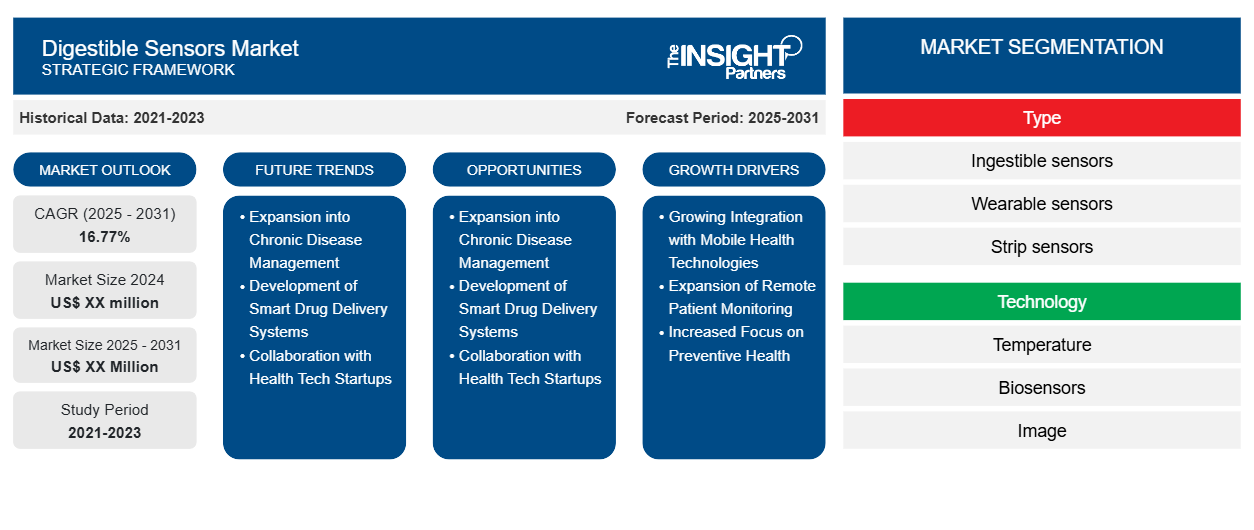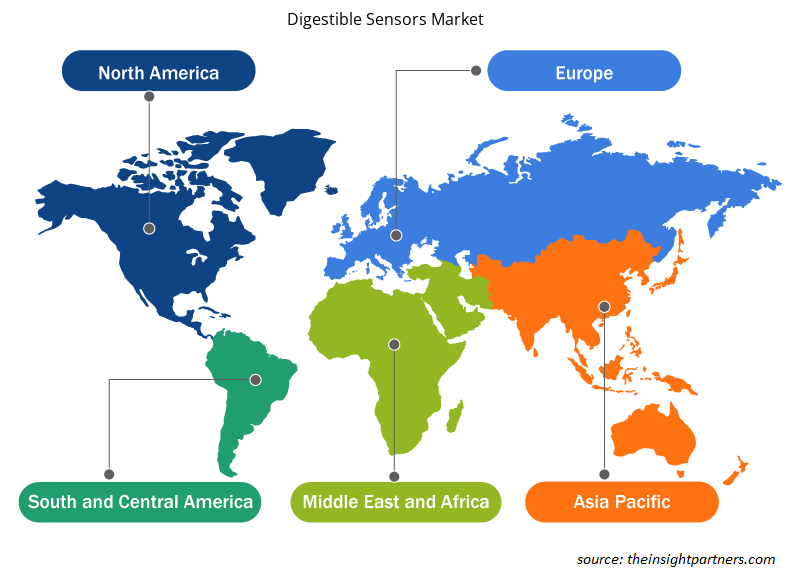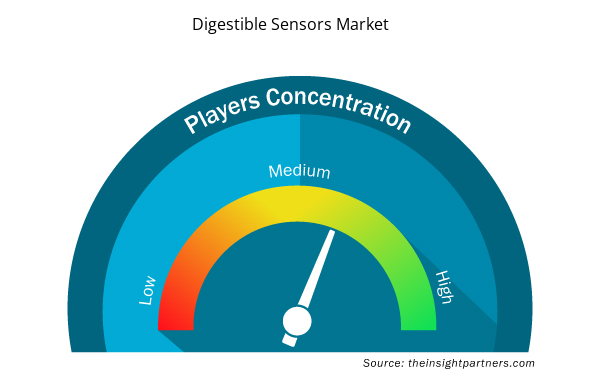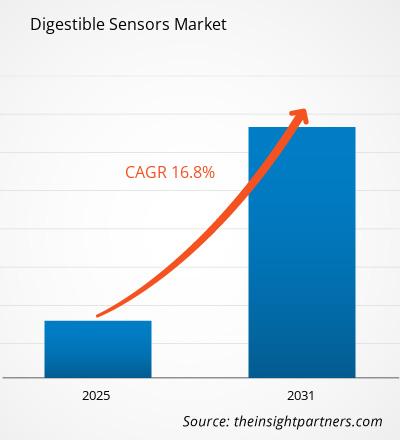Se espera que el mercado de sensores digeribles registre una CAGR del 16,77 % entre 2025 y 2031, con un tamaño de mercado que se expandirá de US$ XX millones en 2024 a US$ XX millones en 2031.
El informe está segmentado por tipo (sensores ingeribles, sensores portátiles, sensores de tira, sensores invasivos y sensores implantables), tecnología (temperatura, biosensores, imagen, presión y acelerómetro), aplicación (diagnóstico, monitoreo de pacientes y terapéutica), usuario final (consumidor, empresas farmacéuticas, proveedores de atención médica, institutos de deportes y fitness y otros).
Propósito del Informe
El informe "Mercado de Sensores Digeribles" de The Insight Partners busca describir el panorama actual y el crecimiento futuro, los principales factores impulsores, los desafíos y las oportunidades. Esto proporcionará información a diversos actores del negocio, como:
- Proveedores/Fabricantes de Tecnología: Para comprender la dinámica cambiante del mercado y conocer las oportunidades potenciales de crecimiento, lo que les permitirá tomar decisiones estratégicas informadas.
- Inversores: Realizar un análisis exhaustivo de tendencias respecto a la tasa de crecimiento del mercado, las proyecciones financieras del mercado y las oportunidades que existen en toda la cadena de valor.
- Organismos reguladores: Regular las políticas y las actividades policiales en el mercado con el objetivo de minimizar el abuso, preservar la confianza de los inversores y defender la integridad y estabilidad del mercado.
Segmentación del mercado de sensores digeribles
Tipo
- Sensores ingeribles
- Sensores portátiles
- Sensores de tira
- Sensores invasivos
- Sensores implantables
Tecnología
- Temperatura
- Biosensores
- Imagen
- Presión
- Acelerómetro
Solicitud
- Diagnóstico
- Monitoreo de pacientes
- Terapéutica
Usuario final
- Consumidor
- Compañías farmacéuticas
- Proveedores de atención médica
- Institutos de deportes y fitness
- Otros
Personalice este informe según sus necesidades
Recibirá personalización de cualquier informe, sin cargo, incluidas partes de este informe o análisis a nivel de país, paquete de datos de Excel, así como también grandes ofertas y descuentos para empresas emergentes y universidades.
Mercado de sensores digeribles: Perspectivas estratégicas

- Obtenga las principales tendencias clave del mercado de este informe.Esta muestra GRATUITA incluirá análisis de datos, desde tendencias del mercado hasta estimaciones y pronósticos.
Impulsores del crecimiento del mercado de sensores digeribles
- Integración creciente con tecnologías de salud móvil: Un impulsor emergente del mercado de sensores de fácil comprensión sería la adopción de tecnologías de salud móvil. Los consumidores ahora monitorean su salud con dispositivos inteligentes y teléfonos inteligentes, y la cuestión radica en que se están diseñando sensores de fácil comprensión para que funcionen con aplicaciones móviles. Esto permite compartir información en tiempo real y facilita que los pacientes comprendan mejor su salud, allanando el camino para la gestión de la salud ACTiVe al ofrecerla de forma más sencilla.
- Expansión de la monitorización remota de pacientes: El aumento de la monitorización remota de pacientes es un factor que influye en el mercado de los sensores digestibles. En situaciones donde los sistemas de atención médica proporcionan instrucciones para la atención las 24 horas, los sensores digestibles ofrecen la posibilidad de monitorizar el estado del tracto gastrointestinal en el domicilio del paciente. Este desarrollo permite a los pacientes continuar con los controles periódicos esenciales desde casa, reduciendo así la rotación de pacientes en los hospitales, lo que a su vez mejora el cumplimiento y el control de la enfermedad por parte del sistema de atención médica.
- Mayor enfoque en la salud preventiva: Si bien la salud preventiva no es un concepto nuevo, el mercado de sensores digestibles está prestando cada vez más atención a esta área, con la necesidad de resolver los problemas antes de que surjan. Un sistema que proporciona a los pacientes el uso de sensores digestibles fantasma que monitorizarán su salud digestiva de forma continua. Esta tendencia indica un cambio más amplio en los sistemas de salud hacia el uso de tecnologías para la mejora de la salud, en lugar de solo el tratamiento.
Tendencias futuras del mercado de sensores digeribles
- Expansión hacia la gestión de enfermedades crónicas: Existen amplias posibilidades de crecimiento en la gestión de enfermedades crónicas en el sector de los sensores digestibles. Los profesionales sanitarios, que buscan métodos más eficientes para controlar la diabetes, enfermedades digestivas, etc., pueden utilizar estos sensores para obtener información útil mientras se lleva el monitor. Esta tecnología resuelve problemas en la gestión de enfermedades crónicas y permite estrategias de tratamiento más personalizadas, lo cual probablemente sea alentador en el paradigma de la atención basada en la valoración.
- Desarrollo de sistemas inteligentes de administración de fármacos: Existe una creciente posibilidad de desarrollar sistemas inteligentes de administración de fármacos con sensores integrados. El uso de estos sistemas, que incluyen la liberación del fármaco y la capacidad de detectar, garantiza la eficacia y el seguimiento del fármaco administrado en cualquier momento. Este novedoso desarrollo podría mejorar la salud de los pacientes con enfermedades debilitantes, lo que ha suscitado el interés de los fabricantes de medicamentos que desean ofrecer sus fármacos en formulaciones mejoradas.
- Colaboración con startups de tecnología sanitaria: El mercado de sensores digeribles es ideal para las startups de tecnología sanitaria que desarrollan soluciones para la salud digital. La participación de estos nuevos actores del mercado facilitaría la creación de una plataforma inteligente que conecte los sensores digeribles con servicios de telesalud, análisis y gestión de la interacción con el paciente. Esto también facilitaría el desarrollo de soluciones sanitarias integrales, atractivas tanto para proveedores como para consumidores interesados en la prestación de servicios integrados.
Oportunidades de mercado de sensores digeribles
- Expansión hacia la gestión de enfermedades crónicas: Existen amplias posibilidades de crecimiento en la gestión de enfermedades crónicas en el sector de los sensores digestibles. Los profesionales sanitarios, que buscan métodos más eficientes para controlar la diabetes, enfermedades digestivas, etc., pueden utilizar estos sensores para obtener información útil mientras se lleva el monitor. Esta tecnología resuelve problemas en la gestión de enfermedades crónicas y permite estrategias de tratamiento más personalizadas, lo cual probablemente sea alentador en el paradigma de la atención basada en la valoración.
- Desarrollo de sistemas inteligentes de administración de fármacos: Existe una creciente posibilidad de desarrollar sistemas inteligentes de administración de fármacos con sensores integrados. El uso de estos sistemas, que incluyen la liberación del fármaco y la capacidad de detectar, garantiza la eficacia y el seguimiento del fármaco administrado en cualquier momento. Este novedoso desarrollo podría mejorar la salud de los pacientes con enfermedades debilitantes, lo que ha suscitado el interés de los fabricantes de medicamentos que desean ofrecer sus fármacos en formulaciones mejoradas.
- Colaboración con startups de tecnología sanitaria: El mercado de sensores digeribles es ideal para las startups de tecnología sanitaria que desarrollan soluciones para la salud digital. La participación de estos nuevos actores del mercado facilitaría la creación de una plataforma inteligente que conecte los sensores digeribles con servicios de telesalud, análisis y gestión de la interacción con el paciente. Esto también facilitaría el desarrollo de soluciones sanitarias integrales, atractivas tanto para proveedores como para consumidores interesados en la prestación de servicios integrados.
Perspectivas regionales del mercado de sensores digeribles
Los analistas de Insight Partners han explicado detalladamente las tendencias y los factores regionales que influyen en el mercado de sensores digestibles durante el período de pronóstico. Esta sección también analiza los segmentos y la geografía del mercado de sensores digestibles en Norteamérica, Europa, Asia Pacífico, Oriente Medio y África, y Sudamérica y Centroamérica.

- Obtenga los datos regionales específicos para el mercado de sensores digeribles
Alcance del informe de mercado de sensores digeribles
| Atributo del informe | Detalles |
|---|---|
| Tamaño del mercado en 2024 | US$ XX millones |
| Tamaño del mercado en 2031 | US$ XX millones |
| CAGR global (2025-2031) | 16,77% |
| Datos históricos | 2021-2023 |
| Período de pronóstico | 2025-2031 |
| Segmentos cubiertos | Por tipo
|
| Regiones y países cubiertos | América del norte
|
| Líderes del mercado y perfiles de empresas clave |
|
Densidad de actores del mercado de sensores digeribles: comprensión de su impacto en la dinámica empresarial
El mercado de sensores digeribles está en rápido crecimiento, impulsado por la creciente demanda del usuario final debido a factores como la evolución de las preferencias del consumidor, los avances tecnológicos y un mayor conocimiento de los beneficios del producto. A medida que aumenta la demanda, las empresas amplían su oferta, innovan para satisfacer las necesidades del consumidor y aprovechan las tendencias emergentes, lo que impulsa aún más el crecimiento del mercado.
La densidad de actores del mercado se refiere a la distribución de empresas o compañías que operan en un mercado o sector en particular. Indica cuántos competidores (actores del mercado) hay en un mercado determinado en relación con su tamaño o valor total.
Las principales empresas que operan en el mercado de sensores digestibles son:
- Dispositivos analógicos, Inc.
- Compañía General Electric
- Honeywell International Inc
- Medtronic plc
- NXP Semiconductors NV
Descargo de responsabilidad : Las empresas enumeradas anteriormente no están clasificadas en ningún orden particular.

- Obtenga una descripción general de los principales actores clave del mercado de sensores digestibles
Puntos clave de venta
- Cobertura integral: el informe cubre de manera integral el análisis de productos, servicios, tipos y usuarios finales del mercado de sensores digestibles, proporcionando un panorama holístico.
- Análisis de expertos: el informe se compila con base en el conocimiento profundo de expertos y analistas de la industria.
- Información actualizada: El informe asegura relevancia comercial debido a su cobertura de información reciente y tendencias de datos.
- Opciones de personalización: este informe se puede personalizar para satisfacer los requisitos específicos del cliente y adaptarse adecuadamente a las estrategias comerciales.
Por lo tanto, el informe de investigación sobre el mercado de sensores digeribles puede ayudar a descifrar y comprender el panorama del sector y sus perspectivas de crecimiento. Si bien existen algunas preocupaciones válidas, las ventajas generales de este informe suelen superar las desventajas.
- Análisis histórico (2 años), año base, pronóstico (7 años) con CAGR
- Análisis PEST y FODA
- Tamaño del mercado Valor/volumen: global, regional, nacional
- Industria y panorama competitivo
- Conjunto de datos de Excel



Report Coverage
Revenue forecast, Company Analysis, Industry landscape, Growth factors, and Trends

Segment Covered
This text is related
to segments covered.

Regional Scope
North America, Europe, Asia Pacific, Middle East & Africa, South & Central America

Country Scope
This text is related
to country scope.
Preguntas frecuentes
The digestible sensors market is estimated to grow with a CAGR of 16.77% from 2023 to 2031.
Asia Pacific region is likely to witness fastest growth rate during the forecast period.
The market drivers include rising demand for personalized healthcare and advancements in biotech and material science are driving the digestible sensors market
The digestible sensors market majorly consists of the players such as Proteus Digital Health, Koninklijke Philips N.V., Honeywell International Inc among others.
Growing integration with mobile health technologies are likely to remain the key trend during the forecast period
North America dominated the digestible sensors market in 2023
Trends and growth analysis reports related to Life Sciences : READ MORE..
1. Analog Devices, Inc.
2. General Electric Company
3. Honeywell International Inc
4. Medtronic plc
5. NXP Semiconductors N.V
6. Philips Healthcare
7. Proteus Digital Health, Inc.
8. Sensirion AG
9. Smiths Group PLC
10. STMicroelectronics N.V
The Insight Partners performs research in 4 major stages: Data Collection & Secondary Research, Primary Research, Data Analysis and Data Triangulation & Final Review.
- Data Collection and Secondary Research:
As a market research and consulting firm operating from a decade, we have published and advised several client across the globe. First step for any study will start with an assessment of currently available data and insights from existing reports. Further, historical and current market information is collected from Investor Presentations, Annual Reports, SEC Filings, etc., and other information related to company’s performance and market positioning are gathered from Paid Databases (Factiva, Hoovers, and Reuters) and various other publications available in public domain.
Several associations trade associates, technical forums, institutes, societies and organization are accessed to gain technical as well as market related insights through their publications such as research papers, blogs and press releases related to the studies are referred to get cues about the market. Further, white papers, journals, magazines, and other news articles published in last 3 years are scrutinized and analyzed to understand the current market trends.
- Primary Research:
The primarily interview analysis comprise of data obtained from industry participants interview and answers to survey questions gathered by in-house primary team.
For primary research, interviews are conducted with industry experts/CEOs/Marketing Managers/VPs/Subject Matter Experts from both demand and supply side to get a 360-degree view of the market. The primary team conducts several interviews based on the complexity of the markets to understand the various market trends and dynamics which makes research more credible and precise.
A typical research interview fulfils the following functions:
- Provides first-hand information on the market size, market trends, growth trends, competitive landscape, and outlook
- Validates and strengthens in-house secondary research findings
- Develops the analysis team’s expertise and market understanding
Primary research involves email interactions and telephone interviews for each market, category, segment, and sub-segment across geographies. The participants who typically take part in such a process include, but are not limited to:
- Industry participants: VPs, business development managers, market intelligence managers and national sales managers
- Outside experts: Valuation experts, research analysts and key opinion leaders specializing in the electronics and semiconductor industry.
Below is the breakup of our primary respondents by company, designation, and region:

Once we receive the confirmation from primary research sources or primary respondents, we finalize the base year market estimation and forecast the data as per the macroeconomic and microeconomic factors assessed during data collection.
- Data Analysis:
Once data is validated through both secondary as well as primary respondents, we finalize the market estimations by hypothesis formulation and factor analysis at regional and country level.
- Macro-Economic Factor Analysis:
We analyse macroeconomic indicators such the gross domestic product (GDP), increase in the demand for goods and services across industries, technological advancement, regional economic growth, governmental policies, the influence of COVID-19, PEST analysis, and other aspects. This analysis aids in setting benchmarks for various nations/regions and approximating market splits. Additionally, the general trend of the aforementioned components aid in determining the market's development possibilities.
- Country Level Data:
Various factors that are especially aligned to the country are taken into account to determine the market size for a certain area and country, including the presence of vendors, such as headquarters and offices, the country's GDP, demand patterns, and industry growth. To comprehend the market dynamics for the nation, a number of growth variables, inhibitors, application areas, and current market trends are researched. The aforementioned elements aid in determining the country's overall market's growth potential.
- Company Profile:
The “Table of Contents” is formulated by listing and analyzing more than 25 - 30 companies operating in the market ecosystem across geographies. However, we profile only 10 companies as a standard practice in our syndicate reports. These 10 companies comprise leading, emerging, and regional players. Nonetheless, our analysis is not restricted to the 10 listed companies, we also analyze other companies present in the market to develop a holistic view and understand the prevailing trends. The “Company Profiles” section in the report covers key facts, business description, products & services, financial information, SWOT analysis, and key developments. The financial information presented is extracted from the annual reports and official documents of the publicly listed companies. Upon collecting the information for the sections of respective companies, we verify them via various primary sources and then compile the data in respective company profiles. The company level information helps us in deriving the base number as well as in forecasting the market size.
- Developing Base Number:
Aggregation of sales statistics (2020-2022) and macro-economic factor, and other secondary and primary research insights are utilized to arrive at base number and related market shares for 2022. The data gaps are identified in this step and relevant market data is analyzed, collected from paid primary interviews or databases. On finalizing the base year market size, forecasts are developed on the basis of macro-economic, industry and market growth factors and company level analysis.
- Data Triangulation and Final Review:
The market findings and base year market size calculations are validated from supply as well as demand side. Demand side validations are based on macro-economic factor analysis and benchmarks for respective regions and countries. In case of supply side validations, revenues of major companies are estimated (in case not available) based on industry benchmark, approximate number of employees, product portfolio, and primary interviews revenues are gathered. Further revenue from target product/service segment is assessed to avoid overshooting of market statistics. In case of heavy deviations between supply and demand side values, all thes steps are repeated to achieve synchronization.
We follow an iterative model, wherein we share our research findings with Subject Matter Experts (SME’s) and Key Opinion Leaders (KOLs) until consensus view of the market is not formulated – this model negates any drastic deviation in the opinions of experts. Only validated and universally acceptable research findings are quoted in our reports.
We have important check points that we use to validate our research findings – which we call – data triangulation, where we validate the information, we generate from secondary sources with primary interviews and then we re-validate with our internal data bases and Subject matter experts. This comprehensive model enables us to deliver high quality, reliable data in shortest possible time.

 Obtenga una muestra gratuita de este informe
Obtenga una muestra gratuita de este informe